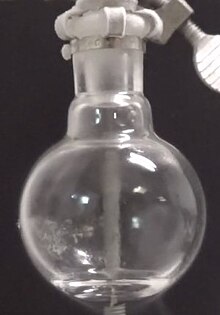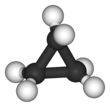Cyclopropane

| |||
| |||
| |||
| Names | |||
|---|---|---|---|
| Preferred IUPAC name
Cyclopropane[2] | |||
| Identifiers | |||
CAS Number
|
|||
3D model (JSmol)
|
|||
| ChEBI | |||
| ChEMBL | |||
| ChemSpider | |||
| ECHA InfoCard | 100.000.771 | ||
| KEGG | |||
PubChem CID
|
|||
| UNII | |||
CompTox Dashboard (EPA)
|
|||
show
InChI | |||
show
SMILES | |||
| Properties | |||
Chemical formula
|
C3H6 | ||
| Molar mass | 42.08 g/mol | ||
| Appearance | Colorless gas | ||
| Odor | Sweet smelling | ||
| Density | 1.879 g/L (1 atm, 0 °C) | ||
| Melting point | −128 °C (−198 °F; 145 K) | ||
| Boiling point | −33 °C (−27 °F; 240 K) | ||
| Acidity (pKa) | ~46 | ||
Magnetic susceptibility (χ)
|
-39.9·10−6 cm3/mol | ||
| Hazards | |||
| Main hazards | Highly flammable Asphyxiant | ||
| Safety data sheet | |||
| NFPA 704 (fire diamond) | 
1
4
0 | ||
Except where otherwise noted, data are given for materials in their standard state (at 25 °C [77 °F], 100 kPa). | |||
| Infobox references | |||
Cyclopropane is the cycloalkane with the molecular formula (CH2)3, consisting of three methylene groups (CH2) linked to each other to form a ring. The small size of the ring creates substantial ring strain in the structure. Cyclopropane itself is mainly of theoretical interest but many of its derivatives are of commercial or biological significance.[3]
History[]
Cyclopropane was discovered in 1881 by August Freund, who also proposed the correct structure for the substance in his first paper.[4] Freund treated 1,3-dibromopropane with sodium, causing an intramolecular Wurtz reaction leading directly to cyclopropane.[5] The yield of the reaction was improved by Gustavson in 1887 with the use of zinc instead of sodium.[6] Cyclopropane had no commercial application until Henderson and Lucas discovered its anaesthetic properties in 1929;[7] industrial production had begun by 1936.[8] In modern anaesthetic practice, it has been superseded by other agents.
Anaesthesia[]
Cyclopropane was introduced into clinical use by the American anaesthetist Ralph Waters who used a closed system with carbon dioxide absorption to conserve this then-costly agent. Cyclopropane is a relatively potent, non-irritating and sweet smelling agent with a minimum alveolar concentration of 17.5%[9] and a blood/gas partition coefficient of 0.55. This meant induction of anaesthesia by inhalation of cyclopropane and oxygen was rapid and not unpleasant. However at the conclusion of prolonged anaesthesia patients could suffer a sudden decrease in blood pressure, potentially leading to cardiac dysrhythmia: a reaction known as "cyclopropane shock".[10] For this reason, as well as its high cost and its explosive nature,[11] it was latterly used only for the induction of anaesthesia, and has not been available for clinical use since the mid 1980s. Cylinders and flow meters were coloured orange.
Pharmacology[]
Cyclopropane is inactive at the GABAA and glycine receptors, and instead acts as an NMDA receptor antagonist.[12][13] It also inhibits the AMPA receptor and nicotinic acetylcholine receptors, and activates certain K2P channels.[12][13][14]
Structure and bonding[]

The triangular structure of cyclopropane requires the bond angles between carbon-carbon covalent bonds to be 60°. The molecule has D3h molecular symmetry. In addition to ring strain, the molecule also has torsional strain due to the eclipsed conformation of its hydrogen atoms. As such, the bonds between the carbon atoms are considerably weaker than in a typical alkane, resulting in much higher reactivity.
Bonding between the carbon centres is generally described in terms of bent bonds.[15] In this model the carbon-carbon bonds are bent outwards so that the inter-orbital angle is 104°. One unusual consequence of bent bonding is that while the C-C bonds in cyclopropane are weaker than normal, the carbon atoms are also closer together than in a regular alkane bond: 151 pm versus 153 pm (average alkene bond: 146 pm).[16]
Delocalization of the six electrons of cyclopropane's three C-C σ bonds was given as an explanation of the only slightly greater strain of cyclopropane ("only" 27.6 kcal/mol) as compared to cyclobutane (26.2 kcal/mol) with cyclohexane as reference with Estr=0 kcal/mol.[17] This stabilization is referred to as σ aromaticity,[18][19] in contrast to the usual π aromaticity, that, for example, is a highly stabilizing effect in benzene. Other studies do not support the role of σ-aromaticity in cyclopropane and the existence of an induced ring current; such studies provide an alternative explanation for the energetic stabilization and abnormal magnetic behaviour of cyclopropane.[20]
Synthesis[]
Cyclopropane was first produced via a Wurtz coupling, in which 1,3-dibromopropane was cyclised using sodium.[4] The yield of this reaction can be improved by the use of zinc as the dehalogenating agent and sodium iodide as a catalyst.[21]
- BrCH2CH2CH2Br + 2 Na → (CH2)3 + 2 NaBr
The preparation of cyclopropane rings is referred to as cyclopropanation.
Cyclopropanes[]
 1-Aminocyclopropane-1-carboxylic acid plays an important role in the biosynthesis of the plant hormone ethylene.[22]
1-Aminocyclopropane-1-carboxylic acid plays an important role in the biosynthesis of the plant hormone ethylene.[22]
Cyclopropane derivatives are numerous.[23] Many biomolecules and pharmaceutical drugs feature the cyclopropane ring. Famous example is aminocyclopropane carboxylic acid, which is the precursor to ethylene, a plant hormone. The pyrethroids are the basis of many insecticides.[3] Several cyclopropane fatty acids are known.
Reactions[]
Owing to the increased π-character of its C-C bonds, cyclopropane can react like an alkene in certain cases. For instance it undergoes hydrohalogenation with mineral acids to give linear alkyl halides. Substituted cyclopropanes also react, following Markovnikov's rule.[24] Substituted cyclopropanes can oxidatively add to transition metals, in a process referred to as C–C activation.
Cyclopropyl groups adjacent to vinyl groups can undergo ring expansion reactions. Examples include the vinylcyclopropane rearrangement and the divinylcyclopropane-cycloheptadiene rearrangement. This reactivity can be exploited to generate unusual cyclic compounds, such as cyclobutenes,[25] or bicyclic species such as the cycloheptene shown below.[26]
Safety[]
Cyclopropane is highly flammable. However, despite its strain energy it is not substantially more explosive than other alkanes.
See also[]
- Tetrahedrane contains four fused cyclopropane rings that form the faces of a tetrahedron
- Propellane contains three cyclopropane rings that share a single central carbon-carbon bond.
- Cyclopropene
- Methylenecyclopropane
References[]
- ^ Merck Index, 11th Edition, 2755.
- ^ "Front Matter". Nomenclature of Organic Chemistry : IUPAC Recommendations and Preferred Names 2013 (Blue Book). Cambridge: The Royal Society of Chemistry. 2014. p. 137. doi:10.1039/9781849733069-FP001. ISBN 978-0-85404-182-4.
- ^ Jump up to: a b Faust, Rüdiger (2001). "Fascinating Natural and Artificial Cyclopropane Architectures". Angewandte Chemie International Edition. 40 (12): 2251–2253. doi:10.1002/1521-3773(20010618)40:12<2251::AID-ANIE2251>3.0.CO;2-R. PMID 11433485.
- ^ Jump up to: a b August Freund (1881). "Über Trimethylen" [On trimethylene]. Journal für Praktische Chemie. 26 (1): 367–377. doi:10.1002/prac.18820260125.
- ^ August Freund (1882). "Über Trimethylen" [On trimethylene]. Monatshefte für Chemie. 3 (1): 625–635. doi:10.1007/BF01516828. S2CID 197767176.
- ^ G. Gustavson (1887). "Ueber eine neue Darstellungsmethode des Trimethylens" [On a new method of preparing trimethylene]. Journal für Praktische Chemie. 36: 300–305. doi:10.1002/prac.18870360127.
- ^ G. H. W. Lucas; V. E. Henderson (1 August 1929). "A New Anesthetic: Cyclopropane : A Preliminary Report". Can Med Assoc J. 21 (2): 173–5. PMC 1710967. PMID 20317448.
- ^ H. B. Hass; E. T. McBee; G. E. Hinds (1936). "Synthesis of Cyclopropane". Industrial & Engineering Chemistry. 28 (10): 1178–81. doi:10.1021/ie50322a013.
- ^ Eger, Edmond I.; Brandstater, Bernard; Saidman, Lawrence J.; Regan, Michael J.; Severinghaus, John W.; Munson, Edwin S. (1965). "Equipotent Alveolar Concentrations of Methoxyflurane, Halothane, Diethyl Ether, Fluroxene, Cyclopropane, Xenon and Nitrous Oxide in the Dog". Anesthesiology. 26 (6): 771–777. doi:10.1097/00000542-196511000-00012. PMID 4378907.
- ^ JOHNSTONE, M; Alberts, JR (July 1950). "Cyclopropane anesthesia and ventricular arrhythmias". British Heart Journal. 12 (3): 239–44. doi:10.1136/hrt.12.3.239. PMC 479392. PMID 15426685.
- ^ MacDonald, AG (June 1994). "A short history of fires and explosions caused by anaesthetic agents". British Journal of Anaesthesia. 72 (6): 710–22. doi:10.1093/bja/72.6.710. PMID 8024925.
- ^ Jump up to: a b Hugh C. Hemmings; Philip M. Hopkins (2006). Foundations of Anesthesia: Basic Sciences for Clinical Practice. Elsevier Health Sciences. pp. 292–. ISBN 978-0-323-03707-5.
- ^ Jump up to: a b Hemmings, Hugh C. (2009). "Molecular Targets of General Anesthetics in the Nervous System". Suppressing the Mind: 11–31. doi:10.1007/978-1-60761-462-3_2. ISBN 978-1-60761-463-0.
- ^ Hara K, Eger EI, Laster MJ, Harris RA (December 2002). "Nonhalogenated alkanes cyclopropane and butane affect neurotransmitter-gated ion channel and G-protein-coupled receptors: differential actions on GABAA and glycine receptors". Anesthesiology. 97 (6): 1512–20. doi:10.1097/00000542-200212000-00025. PMID 12459679. S2CID 21160239.[permanent dead link]
- ^ Eric V. Anslyn and Dennis A. Dougherty. Modern Physical Organic Chemistry. 2006. pages 850-852
- ^ Allen, Frank H.; Kennard, Olga; Watson, David G.; Brammer, Lee; Orpen, A. Guy; Taylor, Robin (1987). "Tables of bond lengths determined by X-ray and neutron diffraction. Part 1. Bond lengths in organic compounds". Journal of the Chemical Society, Perkin Transactions 2 (12): S1–S19. doi:10.1039/P298700000S1.
- ^ S. W. Benson, Thermochemical Kinetics, S. 273, J. Wiley & Sons, New York, London, Sydney, Toronto 1976
- ^ Dewar, M. J. (1984). "Chemical Implications of σ Conjugation". J. Am. Chem. Soc. 106 (3): 669–682. doi:10.1021/ja00315a036.
- ^ Cremer, D. (1988). "Pros and Cons of σ-Aromaticity". Tetrahedron. 44 (2): 7427–7454. doi:10.1016/s0040-4020(01)86238-4.
- ^ Wu, Wei; Ma, Ben; Wu, Judy I-Chia; von Ragué, Schleyer; Mo, Yirong (2009). "Is Cyclopropane Really the σ-Aromatic Paradigm?". Chemistry: A European Journal. 15 (38): 9730–9736. doi:10.1002/chem.200900586. PMID 19562784.
- ^ Wollweber, Hartmund (2000). "Anesthetics, General". Ullmann's Encyclopedia of Industrial Chemistry. Weinheim: Wiley-VCH. doi:10.1002/14356007.a02_289.
- ^ Kende H (1993). "Ethylene biosynthesis". Annu. Rev. Plant Physiol. 44: 283–307. doi:10.1146/annurev.pp.44.060193.001435.
- ^ Rappoport, Zvi, ed. (1995). The Chemistry of the Cyclopropyl Group. The Chemistry of Functional Groups. 2. doi:10.1002/0470023481. ISBN 0471940747.
- ^ Advanced organic Chemistry, Reactions, mechanisms and structure 3ed. Jerry March ISBN 0-471-85472-7
- ^ Fürstner, Alois; Aïssa, Christophe (2006). "PtCl-Catalyzed Rearrangement of Methylenecyclopropanes". Journal of the American Chemical Society. 128 (19): 6306–6307. doi:10.1021/ja061392y. hdl:11858/00-001M-0000-0025-AE20-3. PMID 16683781.
- ^ Wender, Paul A.; Haustedt, Lars O.; Lim, Jaehong; Love, Jennifer A.; Williams, Travis J.; Yoon, Joo-Yong (May 2006). "Asymmetric Catalysis of the [5 + 2] Cycloaddition Reaction of Vinylcyclopropanes and π-Systems". Journal of the American Chemical Society. 128 (19): 6302–6303. doi:10.1021/ja058590u. PMID 16683779.
External links[]
| Wikimedia Commons has media related to Cyclopropane. |
- General anesthetics
- Cyclopropanes
- NMDA receptor antagonists
- Nicotinic antagonists
- AMPA receptor antagonists
- Gases






